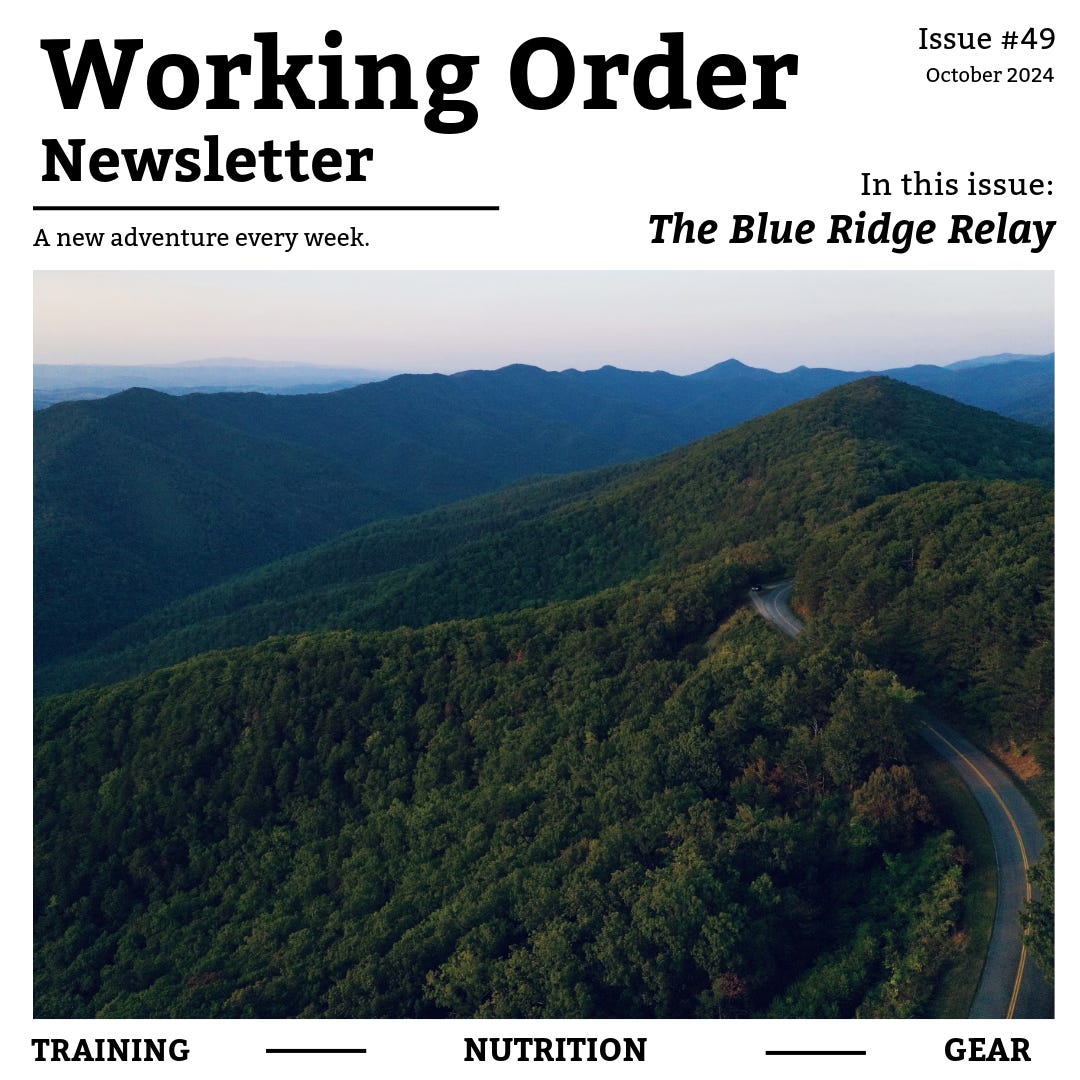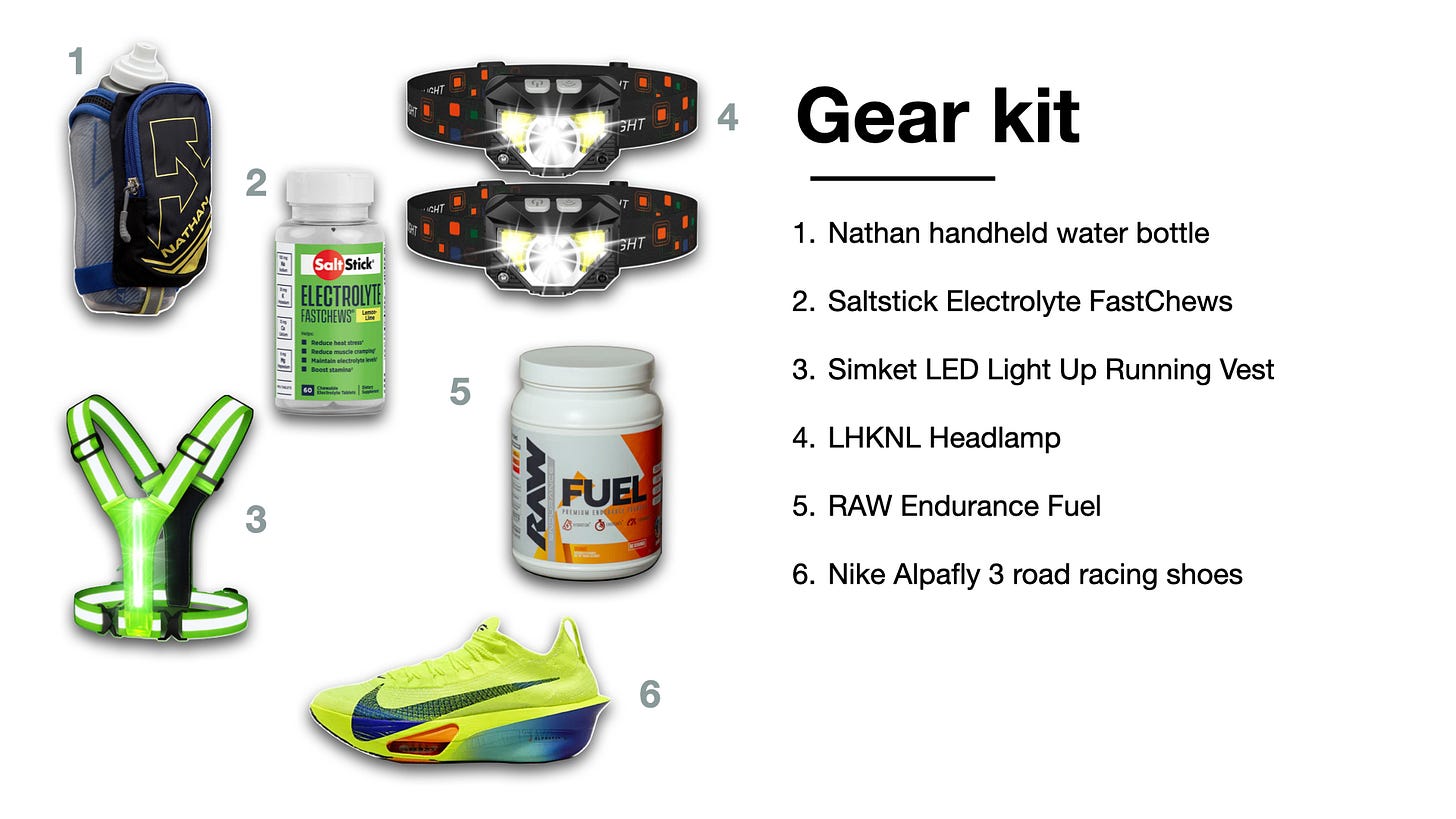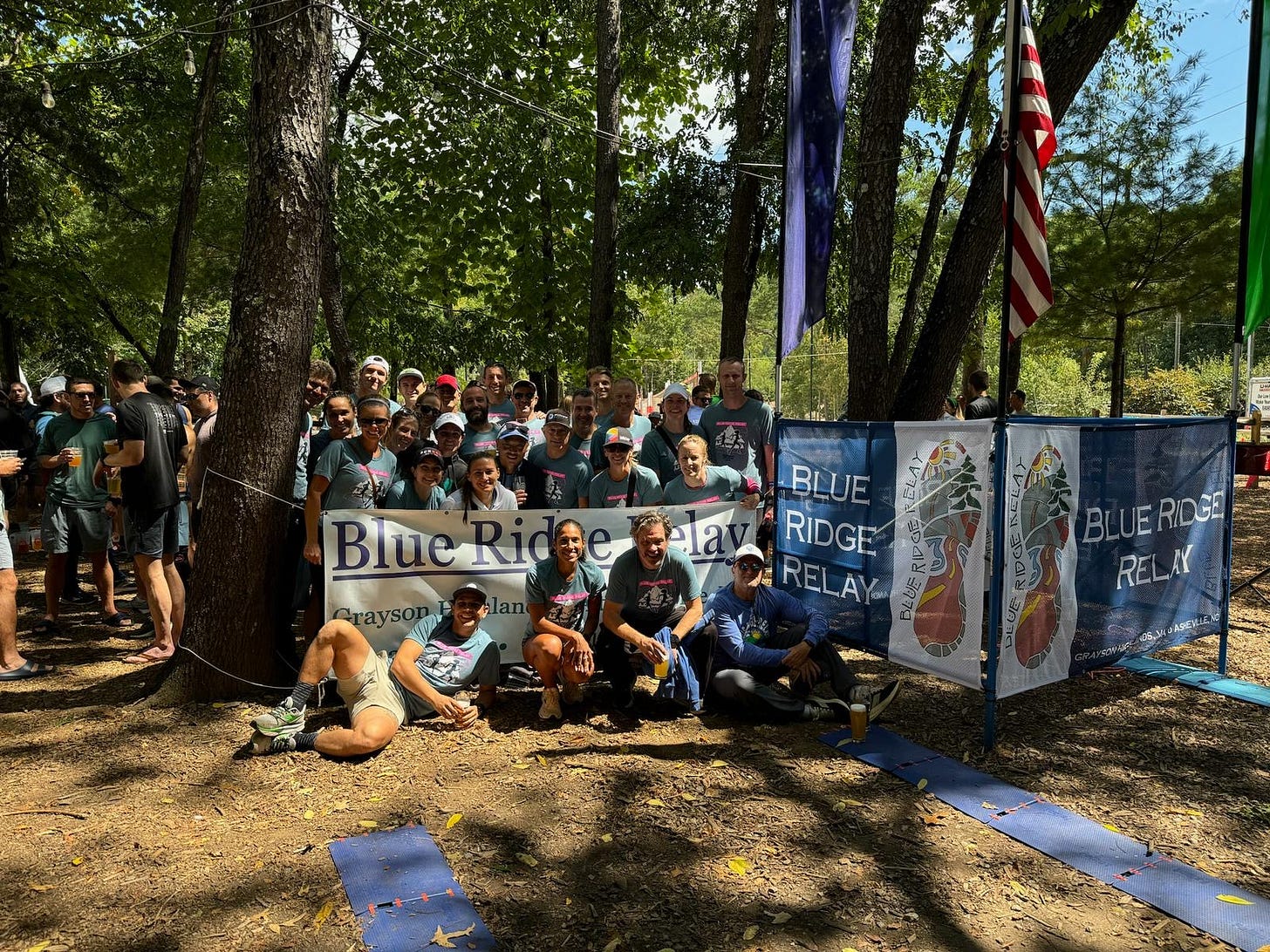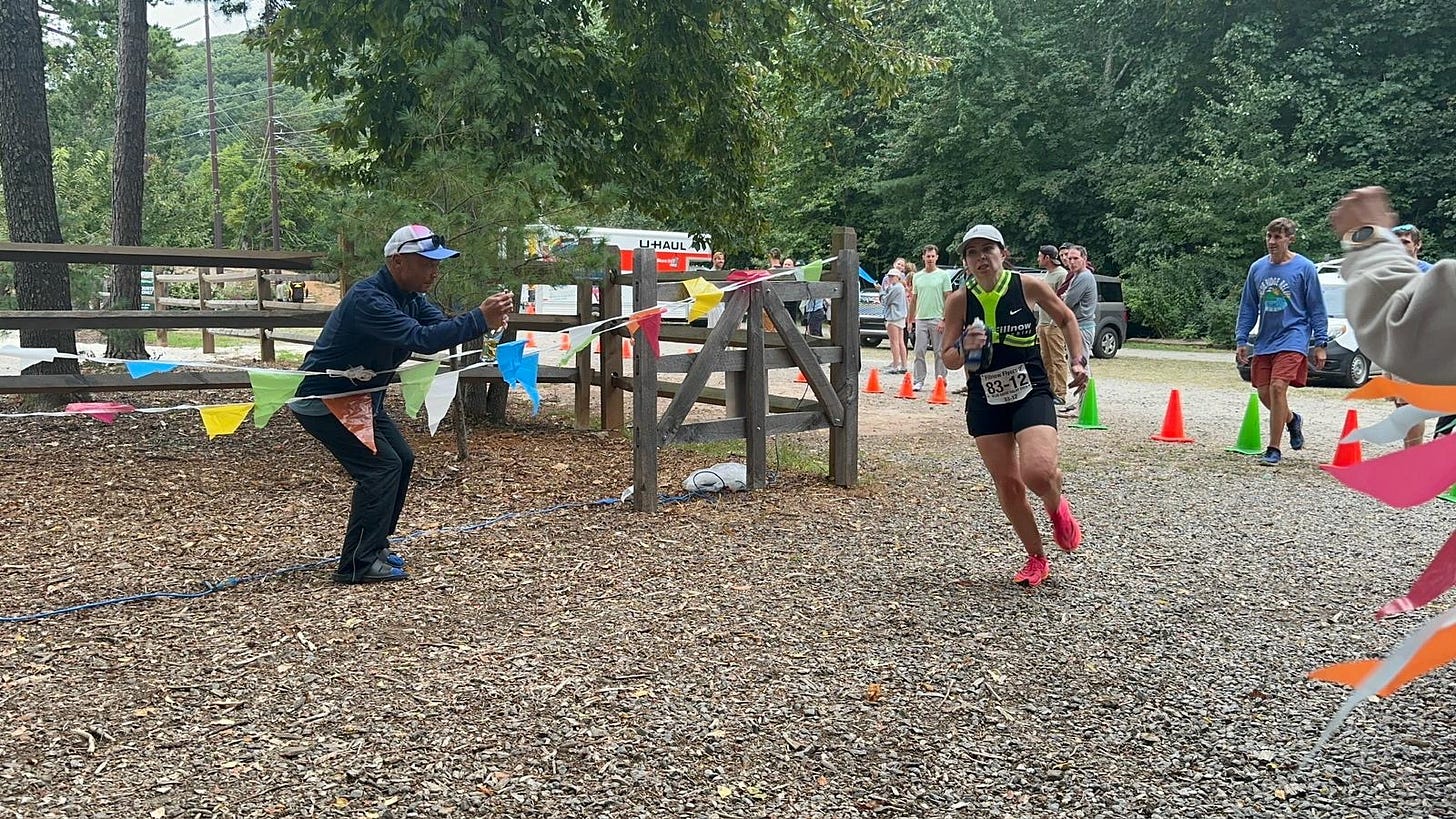The Blue Ridge Relay
A 208 mile relay race through the beautiful Blue Ridge Mountains
Hey there!
Welcome to the Working Order newsletter, where I share a new adventure with you every week and explain how to prepare for it. I’ve included the full conversation above, complete with audio and video. You can also listen to my synopsis if you prefer to keep things short and sweet.
Also, before we dive in, the communities impacted by Hurricane Helene could use a little TLC right now. If you feel inclined, please consider donating any available resources. You can find more information below.

The challenge
What happens when you turn a solo sport like running into a team effort? An unforgettable adventure, that's what. Welcome to the Blue Ridge Relay and the world of relay races.
Stretching 208 miles through some of the oldest mountains in the world is the Blue Ridge Relay. In teams of four to 12, runners have 36 hours to complete this scenic adventure race. It covers over 20 miles of "America's Favorite Drive:" The Blue Ridge Parkway. You'll explore quiet mountain hollows during the day and moon-soaked country roads at night. From start to finish, the Blue Ridge Relay delivers an unparalleled experience.
"For the Blue Ridge Relay, the camaraderie (is why I signed up). Relay races make a team sport out of something that's so individualized. The support and the feeling of people cheering you on and wanting you to be successful is huge for me," says Jen Dubay.
Relay races are popping up everywhere, with organizations like Ragnar leading the pack. They are phenomenal options for folks who want to experience adventure-style races but don't want or have time to train for an ultra.
The biggest draw for this style of racing is the team element. Each runner is responsible for specific sections of the course. For example, your first run could be a midnight 10-miler followed by a sunrise 10k. Oddly enough, as opposed to other running events where the run is the most memorable part, with relay races, the running sometimes takes a backseat to the moments between teammates.
"I would go back and do the Blue Ridge Relay again for that feeling of being with other teammates. It's one of those situations where you don't really care about a PR. You’re running because you know your teammates are waiting for you, and you have this goal that’s bigger than you. When you cross that finish line, you realize what you're capable of," says Jen.
The training
Training for any endurance event is a challenge in and of itself. It's a blend of art and science. Knowing how to structure workouts to target different energy systems is the science. It's the ability to get into the weeds and fine-tune distance, reps, sets, and intensity levels. The art takes a 40,000ft perspective. It blends workouts, deload weeks, and training environments into one beautiful program. Applying these ideas to a relay race where you could run at 5 pm or 5 am adds another layer.
Mimic the experience
Almost every athlete I've spoken with mentions the importance of mimicking your training after the race you're doing. Still, it's worth expanding on. If you're preparing for a relay race, consider running in the morning and again at night.
Doing so means your body will adapt to the stress of running at different times of the day. It will also reduce the stress on your mind. The more relaxed you are, the less effort you perceive it'll take to complete your task, allowing you to run farther.
"I would run multiple times a day," says Jen. "I would run in the morning. Then, I would run after work because I knew I would run multiple times during the day.
Hill workouts
Love 'em or hate 'em, hill work deserves a place in your workout routine. If you're competing at the Blue Ridge Relay, a very hilly course, hill workouts are a must. However, consider incorporating hill training into your regime even if you're not competing on a hilly course. Here's why: Hill training improves your running economy.
The first few workouts may not tire you if you're a seasoned endurance athlete new to hill training. That's because your body is so used to relying on slow-twitch muscle fibers that they don't tire in 8 to 10 seconds. But, as your brain learns to recruit more fast-twitch fibers, you'll become more powerful, translating to longer strides and improved economy.
You have always had a choice.
Not every day will be blue skies and perfect temperatures. You'll have to run in the rain. You'll have to run when you don't feel like it. You'll have good days and off days. You'll have days when you PR despite feeling like shit. You'll have days when you fail despite feeling 100%. It's the nature of the beast. Still, you can choose whether to quit or finish what you started.
"I've had runs before where I've had to stop. I'd start crying because I think, 'I can't even do this during a workout. How am I going to be able to do this during the marathon or this half or whatever race it is?' explains Jen. "Instead of allowing yourself to quit, you must pull it back together. I think those bad workouts can be equally important as the workouts where you feel great. You have to learn to be like, screw it. I'm going to finish this workout, even if it's not pretty; even if the paces are not what I need, I'm gonna get this done."
The nutrition
Getting your nutrition "right" is a fool's errand. You may crush your nutrition plan one race, turn around, follow the same plan on another, and bonk. Your nutrition constantly evolves, meaning you must stay on top of it. During your training is the best time to experiment with what works and what doesn't.
Liquid diet
Just like how a car can't run on empty, neither can your body. Properly fueling for an endurance run like a relay race is essential. Jen gets most of her fuel from liquid carbs, but you may need or want something else.
Take time to experiment during training. Learn what you like and don't like so you can adjust during race day if necessary. "For me, I always put calories and carbs in my liquids. That's what I've found works well. There were no aid stations for the Blue Ridge Relay, so you had to carry your own nutrition. If I'm always consuming energy, I don't bonk," explains Jen.
The gear

The important stuff
A massive thank you to Jen for taking the time to chat about running, the Blue Ridge Relay, and, of course, life. If our chat inspired you to tackle the Blue Ridge Relay, here’s all the important stuff. The communities of Western North Carolina could use a little love right now, so check ‘em out, sign up, and start training. Cheers!
What: Blue Ridge Relay
Where: Grayson Highlands State Park, Virginia to Asheville, North Carolina
When: September 5-6, 2025
Distance: 208 miles broken out over teams of 4 to 12 runners.







I always love your featured adventures Jake, and this one sounds awesome… but you’re going to have to do some UK based ones or my bank cards are going to take one awful battering going to the US!!